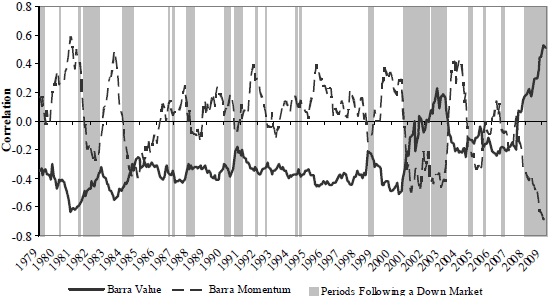Typically, value means unexciting low-beta stocks, and momentum means exciting high-beta stocks. Does “typically” mean always? In their September 2009 paper entitled “The Changing Beta of Value and Momentum Stocks”, Andrea Au and Robert Shapiro investigate the relationships between beta and value and between beta and momentum under varying stock market conditions. Using monthly beta distributions for value (based on book-to-market ratio) and momentum (based on prior 12-month return) sorts of the Russell 3000 stocks over the period December 1978 through March 2009, they conclude that:
- Historically, high value (momentum) stocks are typically low (higher) beta stocks.
- However, during the past couple of years, high value (momentum) stocks have become high (relatively lower) beta stocks. This flip-flop recently reached an extreme not seen in at least 30 years (see chart below).
- During such extremely abnormal intervals:
- Hedged value strategies (value minus growth) dramatically outperform a rising market and dramatically underperform a falling market.
- Hedged momentum strategies (high minus low) underperform a rising market and outperform a falling market.
- Under such conditions, overweighting value (momentum) amounts to an unintended bet on a recovering (relapsing) market.
The following chart, taken from the paper, tracks the correlation between book-to-market ratio and beta (Barra Value) and the correlation between 12-month momentum and beta (Barra Momentum) based on monthly measurements of Russell 3000 stocks over the past 30 years. Gray shading indicates intervals following negative market returns over the preceding six months. During early 2009, the correlations exhibit an extreme flip-flop, such that high value (momentum) stocks now tend to have high (relatively low) betas.

In summary, value-beta and momentum-beta relationships can and recently have reached such extremes that value and momentum strategies may impound untended assumptions about the future market trend.